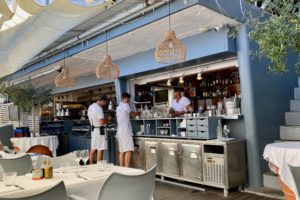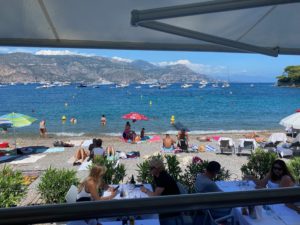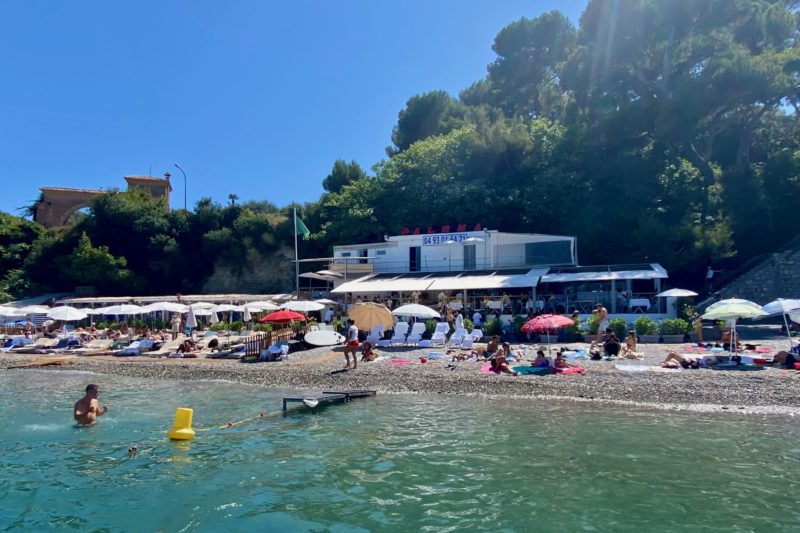The Côte d’Azur has been bulldozing its famous restaurants de plage.
It’s a shocking statement. The vision is even worse. Heaps of tables and woven chairs, refrigerators and ovens, china plates, long-stemmed glasses, and canvas parasols are carted away from France’s beaches. A bulldozer’s jaws then raze the steel pylons and timber platforms that once formed beloved establishments serving everything from shimmering champagne to the perfect, salty pommes frites.
French Lessons has watched this story unfold over the past several years. The movement began as words on paper, but it grabbed our attention when we returned to our home here in 2018. Tétou had disappeared. The courts had decided that the beach restaurant along Golfe Juan was occupying the domaine maritime without right or title. Tétou, and a string of other restaurants de plage, had been demolished in our absence, and a few informal beach concessions had popped up in their place. I’d never visited Tétou, but I knew it formed part of the local lore. The restaurant had opened at the start of the Années Folles – the Roaring Twenties – and had been operated by the same family ever since; it was a favourite among A-listers during the Cannes Film Festival. Cash-only, and not at a small tab, Tétou was famous for its bouillabaisse, a fish soup that servers apparently placed in a steaming pot at the center of a dining table along with a self-service ladle. Now the business had been swept away with no trace – except, if you look for it, Tétou’s name still clings to the former parking lot across the beach road, even as a developer’s sign hangs on the fence.

Private beach restaurants like Tétou have operated in France for generations, and the businesses were getting bigger and bigger. Many argued that their concessions were illegal, contravening France’s loi littoral, a 1986 coastal law that made the beaches free and unrestricted for public use. The loi littoral has become part of the French fabric – but still, it was tough to ignore the hundreds of millions of Euros that beach businesses brought in each year. At each permitting renewal, municipal governments put the concessions out to tender, and between the funds streaming into local purses and the array of jobs created by these restos de plage, people grew comfortable with the status quo.
Then in 2006, the national government issued a decree over the use of France’s beaches. The décret plage aimed to control the balance between coastal protection and leisure activities – or, depending on who you listened to, to liberate the beaches. Either way, the new regulations sought to create meaningful bounds for private beach concessions, which had to be temporary, not permanent, fixtures that could be disassembled at the end of each season.
The décret plage de 2006 swiftly turned into a headache and a stream of scholarly reports and Sénat debates. How many months of the year could these private businesses operate? How much of the beach could they cover? To what extent must “hard” constructions be dismantled after the summer season? What about job losses? Rather than the national government, should local governments make their own rules – especially given the importance of beaches to their budgets?

The Côte d’Azur is in a transition period, we’ve learned, and other beach restaurants – ones that we do know – are living on borrowed time. Earlier this summer we drove a small cruiser to Cap Ferrat, anchored, and took a dinghy into a pebble beach. As we drew closer, I gazed fondly at the twin-storied building nestled against an embankment strewn in parasol pines. Paloma Beach, the business, had opened just after World War II and took its name from Paloma Picasso, who had frequented the spot with her celebrated father.
These days generous, canvas awnings ran the length of this restaurant de plage and shaded platforms of cloth-covered tables and casual bistro benches. A bouquet of parasols shielded transat loungers lining a section of the pebble beach. From these perches, diners and sun worshippers alike could contemplate the craggy coastline, from clifftop Èze Village to a corner of seaside Monaco, and the fleet of cruisers, sailboats, and megayachts that bobbed in the Mediterranean bay in between. The restaurant’s menu was no less awe-inspiring, from its beignets de fleurs de courgettes, freshly-caught loup de mer, and sabayon aux fruits rouges.

Gorgeous and historic as everything was about this place, it’s the memories that I hold dear. We’ve come year after year to Paloma Beach with friends and family. In fact, Lolo, now 16, encountered her first ice cream cone here. (Fortunately, it was vanilla.) But like Tétou before it, the future of Paloma Beach has sustained years of to-and-fro, and the outcome remains uncertain.
On this summer’s visit one employee chatted with Philippe, whose affability and Quebecois-French accent always seem to spark conversation. “Nothing will be left in five years,” the chap said with an air of discernment. “We’ve already lost half the beach.”
Indeed, we’d noticed the changes. Paloma Beach used to extend over half of the beach, but now some of its cream-coloured loungers have been replaced by vibrant beach towels. A full dock used to greet customers coming by sea, but today’s arrivals have to judge the swells before jumping onto a mickey mouse perch. Yes, things are different, and we’d been squeezing our eyes shut, hoping for the best.

Every coin has two sides. The premeditated destruction of thriving businesses always stumped us, but in researching this post, I realise I’ve been thinking like a holidaymaker – a very regular and established holidaymaker, for sure, but a non-resident nonetheless. “It’s more fun here now,” a local friend told me when I told her about this post idea. “As soon as the tourists leave and the kids go back to school, we have picnics on the beaches all the time. We’re using them.” Then she added with a laugh, “I never knew Juan-les-Pins had such nice beaches.”
My friend’s remark encapsulated what’d I’d been toiling to learn. I’d already witnessed the local passion for this access to the coastline. During his visit several years ago, the King of Saudi Arabia appropriated a small beach beside his mansion for security reasons. The narrow stretch of sand, which lay nearby the then-existing Tétou, was fairly inaccessible and lightly used compared to Golfe Juan’s neighbouring beaches, but the closure prompted an outcry, a 150,000-strong petition, and international headlines. (The king left early.)
The coastal situation has led to today’s tricky legal issue. Beach enterprises always operated under leaseholds – not freeholds under which they purchased the land outright. As time passed, and has continued to pass during the transitional period of the décret plage, the leases’ clocks have ticked down. Renewing concessions has become tricky and sometimes impossible. Businesses that chose to operate anyway were doing so illegally. Fifteen years ago, when we first moved to Antibes, I’d watched as the beach shacks along Plage de la Salis were boxed up and carted away at the end of the season. I’d considered it a bunch of unnecessary effort, but now that annual ritual seems the simpler one.
Our time here this summer is dwindling. “We should get to the Plage Provençale one night,” Philippe said the other day.
“Absolutely!” I said. I was more eager than usual for a reservation – sadly for good reason.

Unlike Paloma Beach, Le Provençal Beach (and non, I’m not simplifying matters with English here – these French restaurants choose the word “Beach”) is near our home. Its table linens and stemmed glasses spread along wooden docks that extend beyond the shores of neighbouring Juan-les-Pins – but like its Cap Ferrat cousin, this beach restaurant is filled with our memories. Once, having parked our car on the way to dinner there, we realised we’d forgotten Yoko’s leash. Philippe carried our miniature poodle into the restaurant anyway. When our dog grew tired of our table, she wandered off to other diners, looking for a handout (or a messy eater). No one was stunned by a roaming poodle, and in end, a French bulldog appeared beneath our table. Each autumn, when we return to Toronto and I get rehabilitated by North America’s dogs-in-restaurants rules, this memory from Le Provençal Beach brings me bohemian joy.

Le Provençal Beach sprang up in its current form only a decade or so ago, but it takes a storied name from l’Hôtel Le Provençal, which once operated directly across the ring road. American railway magnate Jay Gould had built the hotel in 1926, when Juan-les-Pins was in its heyday. Edith Piaf had danced in its ballroom, Coco Chanel and Marilyn Monroe had apparently lounged on the terrace, and Ella Fitzgerald gave an impromptu performance from an upstairs window. I’ve only known the hotel as a hulking honeycomb that has blotted Juan-les-Pins’ landscape. The ruin, 10 stories and 175,000 square feet of whitewashed concrete, has outwitted a series of developers over these past years, even as Brad Pitt was supposedly buying in at one point. The latest owner has big designs for a condo building, we hear, but I’ll believe it when I see it.
In any case, I knew why Philippe proposed dinner at Le Provençal Beach before we return to Toronto. Juan-les-Pins, he has learned, is planning to create a sentier du littoral – a seaside boardwalk – in the manner of those sublime, olden days, now a century gone. As the namesake hotel is hoping to rise from its long ruin, one of our cherished beach restaurants will soon fall prey to bulldozers. Unless someone can elongate its lease of life, our meal there will be our last.
French Lessons asks: What’s your take? What are your memories? We’d love to hear from you.
Follow us on Instagram @frenchlessonsblog


Quel domage!
Exactement, David! Et merci – encore fois – for being the first commenter!
Tous les pays européens mettent en place une politique d’accès de tous aux lacs, aux rivières et à la mer. Si c’est fait intelligemment, les bons bistrots et les endroits d’exception survivent, voire même sont protégés et améliorés. Souvent malheureusement, les lieux emblématiques sont détruits au nom de la démocratisation. La France est un pays dirigé du haut vers le bas où on ne sait pas être flexible et juste en même temps. Peut-être les habitant du crû réussiront-ils à faire émerger d’autres lieux où beauté, calme et bonne cuisine pourront se combiner pour le plus grand plaisir des amateurs. Faisons confiance aux jeunes pleins d’idées nouvelles.
Merci, Diane. Nous avons besoin d’un bon équilibre – et oui, je suis curieuse de voir l’avenir. Nos jeunes m’inspirent.
Beach restaurants have always been an important part of the identity and of the charm of the French Riviera. In my own view, as a long time lover of France and of its beautiful Mediterranean shores, seeing those iconic restaurants on a way of extinction is very sad. We know that the commercial and sanitary rules have changed but I think that there are ways to request the restaurants owners to adjust without pushing them to disappear. At least, if the authorities do not want the number of facilities to increase, they should protect an acquired right to the existing facilities even if their owners are changing from time to time. But then again, this is only the opinion of a 50+ years tourist of the French Riviera and certainly not pretending that he knows better than the local authorities and population. And let’s keep on enjoying these cultural destinations while they still exist.
Thanks for your comment, Andy. Let’s hold on to these long memories – and keep raising our glasses in the meantime!
A project for your family to take on perhaps? Lolo Pour Le Provencal”?!!! (Forgive the poor French vocab — I took only two quarters of French lol!) In any case, we would love to visit THAT restaurant!!! 😊
Ha! Love it, Staci. And your idea aligns with Diane’s – which I’m guessing you didn’t realize because of the aforementioned two quarters of French. 😀 Yes, I am heartened by the inspiring crop in the next generation!
Thanks so much for such thorough research and presentation of both sides of this pancake. I really appreciated learning about this, and will cast a more discerning eye next time we’re over there. A real banner issue for sure.
Oh, thank you so much, Tracy. Yes, there was a fair bit of sweat that went into this post. It got me thinking, so I figured the ideas might strike a wider chord.
Despite my tardy response I was very much anticipating the next French Lesson….you did not disappoint. I loved the “bouquet of parasols”.
Perhaps the French government was just being forward-thinking. With the rise of sea levels due to global warming perhaps the restaurants will soon once again be on the beach!!!
Hope you will have time for one more French Lesson before your departure.
Hey, Electa, that’s great that you’re ANTICIPATING the posts. That’s inspiring 😀. Yep, one more to go this summer – that’s the idea anyway. As for the water levels, I’m glad Antibes’ seaward ramparts are as tall as they are and have lasted for centuries…
Jemma, this entire situation has been heartbreaking in many respects. I mean … Tétou??? Sigh … And so many others that supported proud families for generations. There are times when “progress” seems to be going backwards. It hurts to even talk about it. Enjoy your remaining days and thanks for bring some of our beloved Antibes to those of us still pining to return.
Thanks for sharing your thoughts, Patricia. The beaches are still beautiful, and some restos de plage still remain, but the changes are evident for those of us who remember. I, too, hate to see foundations and memories wiped away. And you’re welcome: It’s a pleasure to host this site, even if not all news is cheerful! 😔
I loved going to Tetou! I went there as a little girl with my parents and all of my growing up, and brought my daughters as well. 4 generations of my family have had the Boulliabase. 😥
Merci for your note, Elizabeth. So much tradition about the place – and your story only underscores it!
I had just suggested to someone I know to make sure they get to Tetou from Cannes. Then I saw your blog. Thank you for this blog!